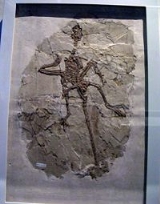
Jixiangornis
Encyclopedia
Jixiangornis is the name given to a genus of basal bird
from the Early Cretaceous
. Like later birds, it had developed a beak
, but it had a long tail, unlike modern birds. Since teeth were still present in some more advanced short-tailed birds, Jixiangornis seems to have evolved its beak independently of modern birds. The long forelimb (131% of hindlimb length) indicates a flying bird. Jixiangornis is currently known only from the type specimen, a complete skeleton. The fossil was found in the Yixian Formation
near Beipiao City, western Liaoning
, China
.
The type and presently only species, J. orientalis ("Oriental bird from the Yixian Formation"), was described in November 2002. Ji et al. (2002) considered Jixiangornis capable of stronger flight than either Archaeopteryx
or Shenzhouraptor
. Their phylogenetic tree shows Jixiangornis forming a clade ("Euavialae" of Ji et al.) with short-tailed birds that excludes Archaeopteryx and Shenzhouraptor.
An alternative view was presented by Zhou Zong-He and Zhang Fu-Cheng in 2006. They classified both Jixiangornis and Shenzhouraptor as junior synonyms of Jeholornis prima, meaning that Jixiangornis cannot be more advanced than Shenzhouraptor. This approach, however, seems problematical given the numerous differences between Jixiangornis and Shenzhouraptor/Jeholornis.
Bird
Birds are feathered, winged, bipedal, endothermic , egg-laying, vertebrate animals. Around 10,000 living species and 188 families makes them the most speciose class of tetrapod vertebrates. They inhabit ecosystems across the globe, from the Arctic to the Antarctic. Extant birds range in size from...
from the Early Cretaceous
Early Cretaceous
The Early Cretaceous or the Lower Cretaceous , is the earlier or lower of the two major divisions of the Cretaceous...
. Like later birds, it had developed a beak
Beak
The beak, bill or rostrum is an external anatomical structure of birds which is used for eating and for grooming, manipulating objects, killing prey, fighting, probing for food, courtship and feeding young...
, but it had a long tail, unlike modern birds. Since teeth were still present in some more advanced short-tailed birds, Jixiangornis seems to have evolved its beak independently of modern birds. The long forelimb (131% of hindlimb length) indicates a flying bird. Jixiangornis is currently known only from the type specimen, a complete skeleton. The fossil was found in the Yixian Formation
Yixian Formation
The Yixian Formation is a geological formation in Jinzhou, Liaoning, People's Republic of China, that spans 11 million years during the early Cretaceous period...
near Beipiao City, western Liaoning
Liaoning
' is a province of the People's Republic of China, located in the northeast of the country. Its one-character abbreviation is "辽" , a name taken from the Liao River that flows through the province. "Níng" means "peace"...
, China
China
Chinese civilization may refer to:* China for more general discussion of the country.* Chinese culture* Greater China, the transnational community of ethnic Chinese.* History of China* Sinosphere, the area historically affected by Chinese culture...
.
The type and presently only species, J. orientalis ("Oriental bird from the Yixian Formation"), was described in November 2002. Ji et al. (2002) considered Jixiangornis capable of stronger flight than either Archaeopteryx
Archaeopteryx
Archaeopteryx , sometimes referred to by its German name Urvogel , is a genus of theropod dinosaur that is closely related to birds. The name derives from the Ancient Greek meaning "ancient", and , meaning "feather" or "wing"...
or Shenzhouraptor
Shenzhouraptor
Jeholornis is a genus of Mesozoic birds that lived approximately 120 million years ago during the Early Cretaceous of China...
. Their phylogenetic tree shows Jixiangornis forming a clade ("Euavialae" of Ji et al.) with short-tailed birds that excludes Archaeopteryx and Shenzhouraptor.
An alternative view was presented by Zhou Zong-He and Zhang Fu-Cheng in 2006. They classified both Jixiangornis and Shenzhouraptor as junior synonyms of Jeholornis prima, meaning that Jixiangornis cannot be more advanced than Shenzhouraptor. This approach, however, seems problematical given the numerous differences between Jixiangornis and Shenzhouraptor/Jeholornis.

